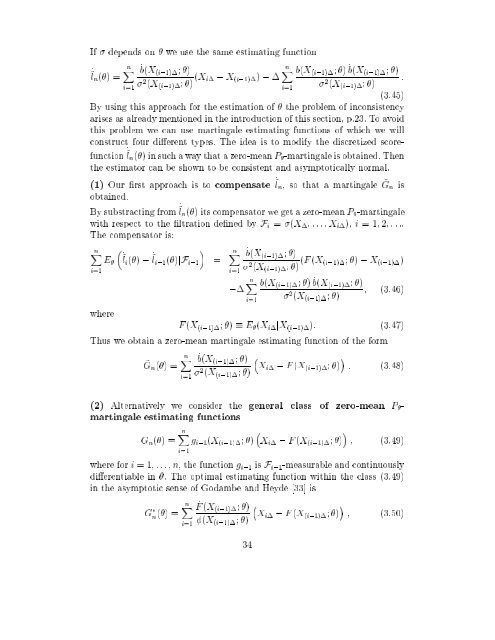Estimation in Financial Models - RiskLab
Estimation in Financial Models - RiskLab
Estimation in Financial Models - RiskLab
Create successful ePaper yourself
Turn your PDF publications into a flip-book with our unique Google optimized e-Paper software.
If depends on we use the same estimat<strong>in</strong>g function<br />
nX<br />
_b(X (i,1) ; )<br />
_~l n () =<br />
<br />
i=1<br />
2 (X (i,1) ; ) (X b(X (i,1) ; ) b(X<br />
i , X (i,1) ) , <br />
_ (i,1) ; )<br />
:<br />
<br />
i=1<br />
2 (X (i,1) ; )<br />
(3.45)<br />
By us<strong>in</strong>g this approach for the estimation of the problem of <strong>in</strong>consistency<br />
arises as already mentioned <strong>in</strong> the <strong>in</strong>troduction of this section, p.23. To avoid<br />
this problem we can use mart<strong>in</strong>gale estimat<strong>in</strong>g functions of which we will<br />
construct four dierent types. The idea is to modify the discretized scorefunction<br />
~ _ ln () <strong>in</strong> suchaway that a zero-mean P -mart<strong>in</strong>gale is obta<strong>in</strong>ed. Then<br />
the estimator can be shown to be consistent and asymptotically normal.<br />
(1) Our rst approach is to compensate _ ~ ln , so that a mart<strong>in</strong>gale ~G n is<br />
obta<strong>in</strong>ed.<br />
By substract<strong>in</strong>g from _ ~ ln () its compensator we get a zero-mean P -mart<strong>in</strong>gale<br />
with respect to the ltration dened by F i = (X ;:::;X i ), i = 1; 2;:::.<br />
The compensator is:<br />
nX <br />
E _<br />
<br />
~ li () , ~ _ <br />
li,1 ()jF i,1<br />
i=1<br />
where<br />
=<br />
nX<br />
i=1<br />
,<br />
nX<br />
_b(X (i,1) ; )<br />
2 (X (i,1) ; ) (F (X (i,1); ) , X (i,1) )<br />
nX<br />
i=1<br />
b(X (i,1) ; ) b(X _ (i,1) ; )<br />
; (3.46)<br />
2 (X (i,1) ; )<br />
F (X (i,1) ; ) E (X i jX (i,1) ): (3.47)<br />
Thus we obta<strong>in</strong> a zero-mean mart<strong>in</strong>gale estimat<strong>in</strong>g function of the form<br />
~G n () =<br />
nX<br />
i=1<br />
_b(X (i,1) ; )<br />
2 (X (i,1) ; )<br />
<br />
Xi , F (X (i,1) ; ) : (3.48)<br />
(2) Alternatively we consider the general class of zero-mean P -<br />
mart<strong>in</strong>gale estimat<strong>in</strong>g functions<br />
G n () =<br />
nX<br />
g i,1 (X (i,1) ; ) X i , F (X (i,1) ; ) ; (3.49)<br />
i=1<br />
where for i =1;:::;n, the function g i,1 is F i,1 -measurable and cont<strong>in</strong>uously<br />
dierentiable <strong>in</strong> . The optimal estimat<strong>in</strong>g function with<strong>in</strong> the class (3.49)<br />
<strong>in</strong> the asymptotic sense of Godambe and Heyde [33] is<br />
G n() =<br />
nX<br />
i=1<br />
_ F (X (i,1) ; )<br />
(X (i,1) ; )<br />
34<br />
<br />
Xi , F (X (i,1) ; ) ; (3.50)
















